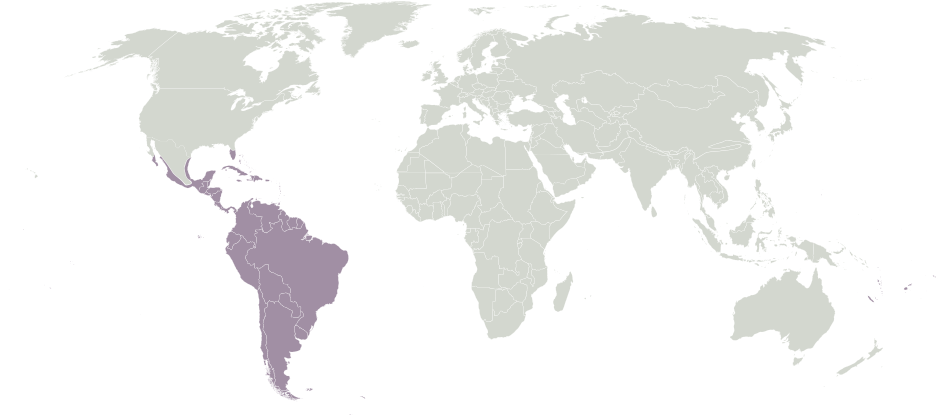Family: Megachilidae
Subfamily: Megachilinae
Tribe: Megachilini
Genus: Megachile Latreille, 1802
Subgenus: Tylomegachile Titus, 1906
Common name: none
Megachile (Tylomegachile) are robust bees with black integumentintegument:
a tough, protective outer layer
on the head, thorax, and abdomen and black to red integumentintegument:
a tough, protective outer layer
on the legs. They range in body length from 9–13 mm (Michener 2007Michener 2007:
Michener, C.D. 2007. The Bees of the World (2nd ed.). Johns Hopkins University Press, Baltimore and London, 953 pp.).
(modified from Michener 2007Michener 2007:
Michener, C.D. 2007. The Bees of the World (2nd ed.). Johns Hopkins University Press, Baltimore and London, 953 pp.; Gonzalez 2008Gonzalez 2008:
Gonzalez, V.H. 2008. Phylogeny and classification of the bee tribe Megachilini (Hymenoptera: Apoidea: Megachilidae), with emphasis on the genus Megachile. Thesis: Department of Ecology and Evolutionary Biology and the College of Liberal Arts and Science of the University of Kansas: 1-274.)
 without apicalapical:
without apicalapical: preapicalpreapical:
preapicalpreapical: apicalapical:
apicalapical:Female Megachile (Tylomegachile) may be confused with bees within the subgenus Megachile (Austromegachile) as they have similar mandibles (Michener 2007Michener 2007:
Michener, C.D. 2007. The Bees of the World (2nd ed.). Johns Hopkins University Press, Baltimore and London, 953 pp.). Female Megachile (Tylomegachile) can be differentiated from Megachile (Austromegachile) by the lack of a preoccipital carinacarina:
a clearly defined ridge or keel, not necessarily high or acute; usually appears on bees as simply a raised line
, lack of white hairbands on the scopascopa:
modified hairs for carrying pollen; often branched and dense hairs on the hind-leg, or on the ventral surface of the abdomen in Megachilidae
, and a flat clypeusclypeus:
a section of the face below the antennae, demarcated by the epistomal sutures (Michener 2007Michener 2007:
Michener, C.D. 2007. The Bees of the World (2nd ed.). Johns Hopkins University Press, Baltimore and London, 953 pp.). Megachile (Tylomegachile) males have a small median tooth on the T6T6:
the segments on the top side of the abdomen, often abbreviated when referring to a specific segment to T1, T2, T3, T4, T5, T6, or T7 preapicalpreapical:
preapicalpreapical:
referring to a section of a bee that is physically found just before the outermost (or apical) end of the section or segment
carinacarina:
a clearly defined ridge or keel, not necessarily high or acute; usually appears on bees as simply a raised line
that is not present on the T6T6:
the segments on the top side of the abdomen, often abbreviated when referring to a specific segment to T1, T2, T3, T4, T5, T6, or T7 preapicalpreapical:
preapicalpreapical:
referring to a section of a bee that is physically found just before the outermost (or apical) end of the section or segment
carinacarina:
a clearly defined ridge or keel, not necessarily high or acute; usually appears on bees as simply a raised line
of Megachile (Austromegachile) (Michener 2007Michener 2007:
Michener, C.D. 2007. The Bees of the World (2nd ed.). Johns Hopkins University Press, Baltimore and London, 953 pp.).
Megachile (Tylomegachile) has been observed collecting from Asteraceae, Convolvulaceae, Fabaceae, Lamiaceae, Lauraceae, Papilionaceae, and Mimosaceae (Heithaus 1979Heithaus 1979:
Heithaus, E.R. 1979. Flower-feeding specialization in wild bee and wasp communities in seasonal Neotropical habitats. Oecologia 42(2): 179-194.; Raw 2007Raw 2007:
Raw, A. 2007. An annotated catalogue of the leafcutter and mason bees (genus Megachile ) of the Neotropics. Zootaxa 1601: 1-127.).
Megachile (Tylomegachile) are cavity-nesters and have been observed nesting in trap nests; other aspects of their nesting biology are currently unknown (Ferreira de Costa and Gonçalves 2019).
Megachile (Tylomegachile) consists of eight species; none are known to occur in the U.S. or Canada (Michener 2007Michener 2007:
Michener, C.D. 2007. The Bees of the World (2nd ed.). Johns Hopkins University Press, Baltimore and London, 953 pp.).
There are no known invasives.
Megachile (Tylomegachile) are native to the Americas. They are found as far north as Mexico and in South America as far south as Argentina (Michener 2007Michener 2007:
Michener, C.D. 2007. The Bees of the World (2nd ed.). Johns Hopkins University Press, Baltimore and London, 953 pp.; Raw 2007Raw 2007:
Raw, A. 2007. An annotated catalogue of the leafcutter and mason bees (genus Megachile ) of the Neotropics. Zootaxa 1601: 1-127.).

Distribution map generated by Discover Life -- click on map for details, credits, and terms of use.
Ferreira da Costa, C.C. and R.B. Gonçalves. 2019. What do we know about NeotropicalNeotropical:
biogeographic region that includes South and Central America, the Caribbean Islands, southern Florida, and the southern Mexican lowlands trap-nesting bees? Synopsis about their nest biology and taxonomy. Papéis Avulsos de Zoologia 59, e20195926.
trap-nesting bees? Synopsis about their nest biology and taxonomy. Papéis Avulsos de Zoologia 59, e20195926.
Gonzalez, V.H. 2008. Phylogeny and classification of the bee tribe Megachilini (Hymenoptera: Apoidea: Megachilidae), with emphasis on the genus Megachile. Thesis: Department of Ecology and Evolutionary Biology and the College of Liberal Arts and Science of the University of Kansas: 1-274.
Heithaus, E.R. 1979. Flower-feeding specialization in wild bee and wasp communities in seasonal NeotropicalNeotropical:
biogeographic region that includes South and Central America, the Caribbean Islands, southern Florida, and the southern Mexican lowlands habitats. Oecologia 42(2): 179-194.
habitats. Oecologia 42(2): 179-194.
Michener, C.D. 2007. The Bees of the World (2nd ed.). Johns Hopkins University Press, Baltimore and London, 953 pp.
Raw, A. 2007. An annotated catalogue of the leafcutter and mason bees (Genus Megachile) of the Neotropics. Zootaxa 1906: 1-127.